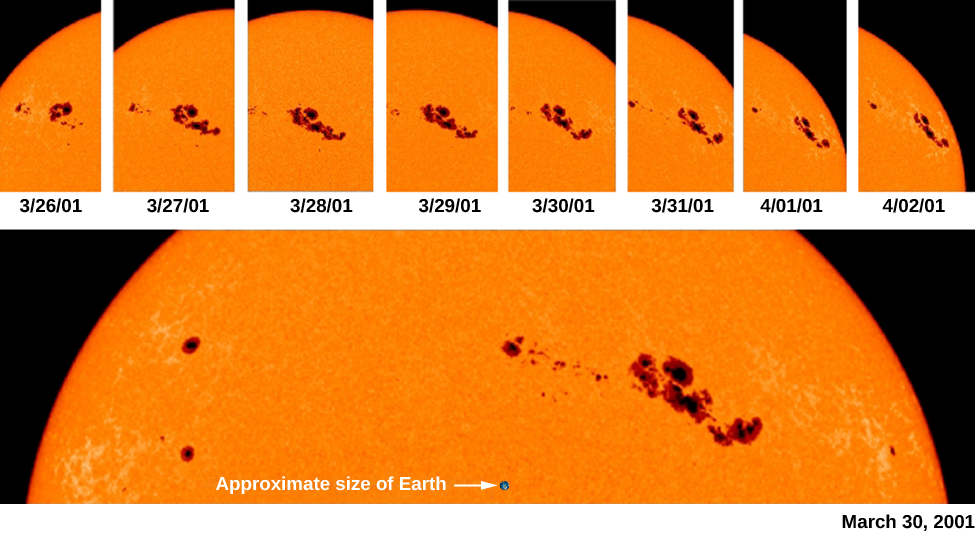| << Chapter < Page | Chapter >> Page > |
By recording the apparent motions of the sunspots as the turning Sun carried them across its disk ( [link] ), Galileo , in 1612, demonstrated that the Sun rotates on its axis with a rotation period of approximately 1 month. Our star turns in a west-to-east direction, like the orbital motions of the planets. The Sun, however, is a gas and does not have to rotate rigidly, the way a solid body like Earth does. Modern observations show that the speed of rotation of the Sun varies according to latitude, that is, it’s different as you go north or south of the Sun’s equator. The rotation period is about 25 days at the equator, 28 days at latitude 40°, and 36 days at latitude 80°. We call this behavior differential rotation .

Between 1826 and 1850, Heinrich Schwabe , a German pharmacist and amateur astronomer, kept daily records of the number of sunspots. What he was really looking for was a planet inside the orbit of Mercury, which he hoped to find by observing its dark silhouette as it passed between the Sun and Earth. He failed to find the hoped-for planet, but his diligence paid off with an even-more important discovery: the sunspot cycle . He found that the number of sunspots varied systematically, in cycles about a decade long.
What Schwabe observed was that, although individual spots are short lived, the total number visible on the Sun at any one time was likely to be very much greater at certain times—the periods of sunspot maximum —than at other times—the periods of sunspot minimum . We now know that sunspot maxima occur at an average interval of 11 years, but the intervals between successive maxima have ranged from as short as 9 years to as long as 14 years. During sunspot maxima , more than 100 spots can often be seen at once. Even then, less than one-half of one percent of the Sun’s surface is covered by spots ( [link] ). During sunspot minima , sometimes no spots are visible. The Sun’s activity reached its most recent maximum in 2014.
Watch this brief video from NASA’s Goddard Space Flight Center that explains the sunspot cycle.
Now that we have discussed the Sun’s activity cycle, you might be asking, “Why does the Sun change in such a regular way?” Astronomers now understand that it is the Sun’s changing magnetic field that drives solar activity.
The solar magnetic field is measured using a property of atoms called the Zeeman effect . Recall from Radiation and Spectra that an atom has many energy levels and that spectral lines are formed when electrons shift from one level to another. If each energy level is precisely defined, then the difference between them is also quite precise. As an electron changes levels, the result is a sharp, narrow spectral line (either an absorption or emission line, depending on whether the electron’s energy increases or decreases in the transition).

Notification Switch
Would you like to follow the 'Astronomy' conversation and receive update notifications?